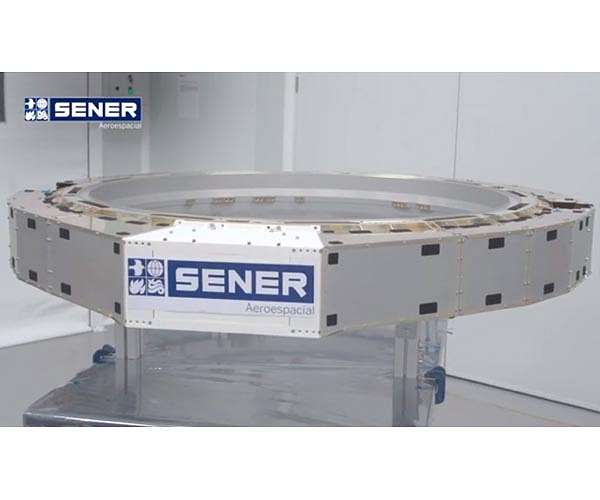
SENER completes hard capture system for universal docking mechanism (Image Credit: Space Daily)
SENER Aeroespacial has developed the Hard Capture System (HCS) for the IBDM (International Berthing and Docking Mechanism), which is the European androgynous low impact docking system that allows both large and small spacecraft to berth and dock.
SENER Aeroespacial takes part in the IBDM as part as the European consortium, developing the HCS. It is an extremely precise and complex system which has the purpose of providing a rigid connection between structures in order to allow for a pressurized passageway between two spacecraft. It also includes connections for the transfer of electrical power, data and fluids such as fuel.
The IBDM has been designed to be compatible with the International Docking System Standard (IDSS) and hence compatible with the ISS International Docking Adapters (IDA) on the US side of the International Space Station (ISS). The possibility of modifying the system to accommodate new docking standards has been taken into account during the project phase, so it has the required flexibility to allow the integration of the IBDM into different vehicles. In fact, thanks to its versatility, this system may become a standard for manned space missions in the future.
One of its potential applications is in the successor of the International Space Station, the Gateway station, whose construction, with SENER Aeroespacial participation with five different contracts, is planned for 2025. Ultimately, Gateway will be embedded in space around the Moon and will serve as a strategic point for distant space expeditions, such as a manned flight to Mars. Part of it will be the I-HAB, a habitat for astronauts arriving from Earth, developed by ESA member companies. I-HAB is expected to be equipped with the HCS system developed by SENER Aeroespacial.
The main components of the HCS developed by SENER Aeroespacial (in charge of design, implementation, integration and testing) are:
+ HCS Tunnel Assembly, which provides the structural integrity and accommodates seals, alignment pins and sensors.
+ HCS Hooks, with 12 independently driven hook units to achieve the structural mating, seal compressions and interface preload. It also accommodates the Contingency Release Devices, based on pyrobolts.
+ Separation System (three separators), which generates the required axial thrust to push off the hoisting vehicle from the ISS once the hooks are opened.
+ Two Resource Transfer Umbilical, with connectors to transfer power and data.
+ MMOD Cover, a Micro Meteorite and Orbital Debris Cover.
+ Thermal Control, active and passive (Multi-layer Insulation over the MMOD).
(stock image only)
Related Links
SENER Aeroespacial
Space Tourism, Space Transport and Space Exploration News
|
|
Tweet |
|
|
|
We need your help. The SpaceDaily news network continues to grow but revenues have never been harder to maintain. With the rise of Ad Blockers, and Facebook – our traditional revenue sources via quality network advertising continues to decline. And unlike so many other news sites, we don’t have a paywall – with those annoying usernames and passwords. Our news coverage takes time and effort to publish 365 days a year. If you find our news sites informative and useful then please consider becoming a regular supporter or for now make a one off contribution. |
||
|
SpaceDaily Monthly Supporter $5+ Billed Monthly |
SpaceDaily Contributor $5 Billed Once credit card or paypal |
|
Developing design tools for outer space structures
West Lafayette IN (SPX) Mar 17, 2022
Achieving affordable space exploration will require lightweight structures for vehicles, solar arrays and antennas. Lightweight materials also will be used for components of structures like pressurized habitats, cryogenic tanks, landing gears and truss cages.
The problem is that NASA envisions that many of those structures will be made from tailorable composite materials, but no design tool has been able to fully exploit the materials’ full potential. AnalySwi … read more









